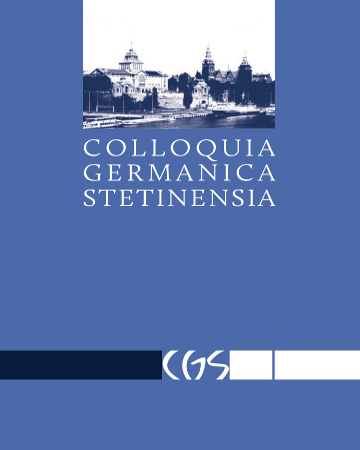








| Authors: |
Marcelina
Kałasznik

Instytut Filologii Germańskiej, Uniwersytet Wrocławski |
| Keywords: | doctors designations doctors evaluation portals naming motives |
| Data publikacji całości: | 2019 |
| Page range: | 16 (203-218) |
| Downloads ?: | 672 |
| 1. | Bauer, Christina. „Arztbewertung: Portale werden immer wichtiger“. Ärzte Zeitung 150D (2017): 6. |
| 2. | Braun, Peter. „Personenbezeichnungen der Mensch in der deutschen Sprache“. Muttersprache 100 (1990): 167–191. |
| 3. | Braun, Peter. Personenbezeichnungen: der Mensch in der deutschen Sprache. Tübingen: Niemeyer, 1997. |
| 4. | DocInsider. Zugriff 18.01.2019. https://www.docinsider.de/. |
| 5. | Dornseiff, Franz. Der deutsche Wortschatz nach Sachgruppen. Berlin: de Gruyter, 2012. |
| 6. | DrEd. Zugriff 18.01.2019. https://www.dred.com/de/. |
| 7. | Duden. Zugriff 23.10.2018. https://www.duden.de/rechtschreibung/Arzt. |
| 8. | DWDS. Zugriff 23.10.2018. https://www.dwds.de/wb/Arzt. |
| 9. | Ewald, Petra. „Vom Stürmer-Dino bis zum Comeback-Experten Miroslav Klose – Merkmalzuschreibung in Individualbenennungen von Sportlern“. In: Sprachkontakte und Lexikon. Festschrift zum 65. Geburtstag von Prof. Ryszard Lipczuk, hrsg. v. Jolanta Mazurkiewicz-Sokołowska, Dorota Misiek, Werner Westphal, 47–60. Hamburg: Verlag Dr. Kovač, 2013. |
| 10. | Fleischer, Wolfgang. „Zum Verhältnis von Name und Appellativum im Deutschen“. Wissenschaftliche Zeitschrift der Karl-Marx-Universität Leipzig 13 (1964): 369–378. |
| 11. | Gładysz, Marek. „Kreativität und Sprachlust bei der Mehrfachbenennung“. In: Sprachlust – Norm – Kreativität. Materialien der internationalen Linguistenkonferenz Karpacz 12.–14.09.2015, hrsg. v. Lesław Cirko, Martin Grimberg, 83–93. Dresden, Wrocław: Neisse Verlag, 2007. |
| 12. | Heinrich, Christian. „Ein Zeugnis für den Doktor“, 10.03.2016. Zugriff 15.03.2018. http://www.zeit.de/2016/12/bewertungsportale-jameda-aerzte-bewertung-vergleich. |
| 13. | Jameda. Zugriff 18.01.2019. https://www.jameda.de/. |
| 14. | Kany, Werner. Inoffizielle Personennamen. Bildung, Bedeutung und Funktion. Tübingen: Max Niemeyer Verlag, 1992. |
| 15. | Krebszweitmeinung. Zugriff 18.01.2019. https://krebszweitmeinung.de/. |
| 16. | Krüger-Brand, Heike E. „Arztportale: Von der Zweitmeinung bis zur Ferntherapie“. Deutsches Ärzteblatt 49/108 (2011): 2640. |
| 17. | Laschet, Helmut. „Bewertungsportale: Ärzte stehen nicht am Pranger“. Ärzte Zeitung 116 (2014): 1. |
| 18. | Nübling, Damaris, Fabian Fahlbusch, Rita Heuser. Namen: Eine Einführung in die Onomastik. Tübingen: Narr France Attempto Verlag, 2012. |
| 19. | O’Reilly, Tim. „What Is Web 2.0. Design Patterns and Business Models for the Next Generation of Software“, 30.08.2005. Zugriff 29.01.2019. https://www.oreilly.com/pub/a/web2/archive/what-is-web-20.html. |
| 20. | Schippan, Thea. Lexikologie der deutschen Gegenwartssprache, Tübingen: Max Niemeyer Verlag, 2002. |
| 21. | Spieß, Constanze. „Die sprachlich-diskursive Konstitution von Weltanschauung und Weltbild im Stammzellendiskurs durch Lexik, Metaphorik und Argumentationsmuster“. Tekst i Dyskurs/Text und Diskurs 4 (2011): 133–156. |
| 22. | Stocker, Christa. Sprachgeprägte Frauenbilder. Soziale Stereotype im Mädchenbuch des 19. Jahrhunderts und ihre distinktive Konstituierung. Tübingen: Max Niemeyer Verlag, 2005. |
| 23. | Wanzeck, Christiane. Zur Etymologie lexikalisierter Farbwortverbindungen. Untersuchungen anhand der Farben Rot, Gelb, Grün und Blau. Amsterdam, New York, 2003. |
| 24. | Weiße-Liste. Zugriff 18.01.2019. https://www.weisse-liste.de/de/. |
| 25. | Woxikon. Zugriff 23.10.2018. https://synonyme.woxikon.de/synonyme/arzt.php. |